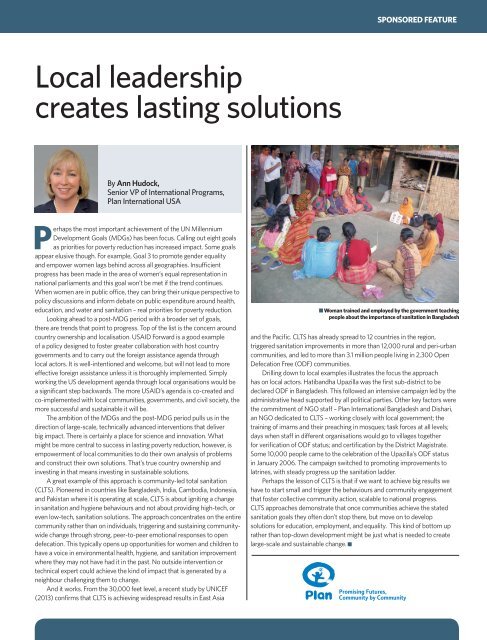FAMBB
FAMBB
FAMBB
You also want an ePaper? Increase the reach of your titles
YUMPU automatically turns print PDFs into web optimized ePapers that Google loves.
SPONSORED FEATURELocal leadershipcreates lasting solutionsBy Ann Hudock,Senior VP of International Programs,Plan International USAPerhaps the most important achievement of the UN MillenniumDevelopment Goals (MDGs) has been focus. Calling out eight goalsas priorities for poverty reduction has increased impact. Some goalsappear elusive though. For example, Goal 3 to promote gender equalityand empower women lags behind across all geographies. Insufficientprogress has been made in the area of women’s equal representation innational parliaments and this goal won’t be met if the trend continues.When women are in public office, they can bring their unique perspective topolicy discussions and inform debate on public expenditure around health,education, and water and sanitation – real priorities for poverty reduction.Looking ahead to a post-MDG period with a broader set of goals,there are trends that point to progress. Top of the list is the concern aroundcountry ownership and localisation. USAID Forward is a good exampleof a policy designed to foster greater collaboration with host countrygovernments and to carry out the foreign assistance agenda throughlocal actors. It is well-intentioned and welcome, but will not lead to moreeffective foreign assistance unless it is thoroughly implemented. Simplyworking the US development agenda through local organisations would bea significant step backwards. The more USAID’s agenda is co-created andco-implemented with local communities, governments, and civil society, themore successful and sustainable it will be.The ambition of the MDGs and the post-MDG period pulls us in thedirection of large-scale, technically advanced interventions that deliverbig impact. There is certainly a place for science and innovation. Whatmight be more central to success in lasting poverty reduction, however, isempowerment of local communities to do their own analysis of problemsand construct their own solutions. That’s true country ownership andinvesting in that means investing in sustainable solutions.A great example of this approach is community-led total sanitation(CLTS). Pioneered in countries like Bangladesh, India, Cambodia, Indonesia,and Pakistan where it is operating at scale, CLTS is about igniting a changein sanitation and hygiene behaviours and not about providing high-tech, oreven low-tech, sanitation solutions. The approach concentrates on the entirecommunity rather than on individuals, triggering and sustaining communitywidechange through strong, peer-to-peer emotional responses to opendefecation. This typically opens up opportunities for women and children tohave a voice in environmental health, hygiene, and sanitation improvementwhere they may not have had it in the past. No outside intervention ortechnical expert could achieve the kind of impact that is generated by aneighbour challenging them to change.And it works. From the 30,000 feet level, a recent study by UNICEF(2013) confirms that CLTS is achieving widespread results in East AsiaWoman trained and employed by the government teachingpeople about the importance of sanitation in Bangladeshand the Pacific. CLTS has already spread to 12 countries in the region,triggered sanitation improvements in more than 12,000 rural and peri-urbancommunities, and led to more than 3.1 million people living in 2,300 OpenDefecation Free (ODF) communities.Drilling down to local examples illustrates the focus the approachhas on local actors. Hatibandha Upazilla was the first sub-district to bedeclared ODF in Bangladesh. This followed an intensive campaign led by theadministrative head supported by all political parties. Other key factors werethe commitment of NGO staff – Plan International Bangladesh and Dishari,an NGO dedicated to CLTS – working closely with local government; thetraining of imams and their preaching in mosques; task forces at all levels;days when staff in different organisations would go to villages togetherfor verification of ODF status; and certification by the District Magistrate.Some 10,000 people came to the celebration of the Upazilla’s ODF statusin January 2006. The campaign switched to promoting improvements tolatrines, with steady progress up the sanitation ladder.Perhaps the lesson of CLTS is that if we want to achieve big results wehave to start small and trigger the behaviours and community engagementthat foster collective community action, scalable to national progress.CLTS approaches demonstrate that once communities achieve the statedsanitation goals they often don’t stop there, but move on to developsolutions for education, employment, and equality. This kind of bottom uprather than top-down development might be just what is needed to createlarge-scale and sustainable change.


